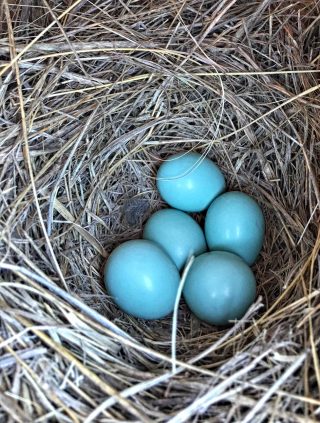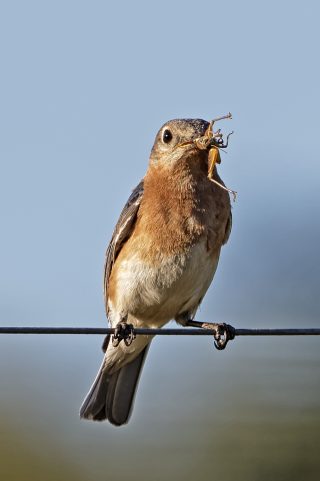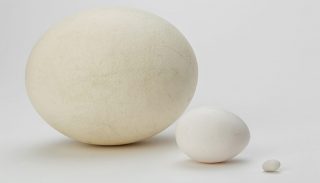
A pair of Eastern Bluebirds has built a nest in the wooden box nailed to a post at the end of our vineyard. The female has settled in to incubating five beautiful blue eggs that will hatch in about 13 days. Robert Benson photo.
The Wonder of Eggs – Karen L. P. Benson
Although new green leaves, bird song, and wildflowers herald the arrival of springtime, there is nothing to compare with the egg to symbolize a new beginning. Eggs are icons of birth and rebirth, spring celebrations, religious renewal, and of course, for many of us, Easter.
Can you imagine entering a store at this time of year and NOT seeing oodles of multi-colored plastic eggs? And, here in south Texas, those bags of plastic eggs are accompanied by stacks of cardboard cartons filled with “cascarones.” For those of you not from Texas, cascarones are hollowed-out hens’ eggs, dyed bright colors, and filled with confetti. The opening in the egg is covered with a bit of tissue paper to keep the confetti inside, until the cascarón is cracked over some celebrant’s head. The resulting shower of confetti is said to bring good luck to the recipient of the act.
The egg is central to many cultures’ spring celebrations. As a child, I helped make “Easter eggs” as part of our Germanic and Eastern European heritage. For weeks we carefully cracked open our breakfast eggs by making a dime-sized hole in the large end of the eggs. We emptied the contents into the skillet, washed out the shell, and let it dry on the kitchen windowsill. We kids knew Easter was coming by the line of eggshells collecting on the sill. Just before the holiday weekend we dyed the eggs pretty colors (the inside of the shell was always so much more brilliant than the outside!). Then the whole family sat at the kitchen table and stuffed the eggs with candies, small toys, and raisins (ugh!) We applied paste to the edges of the hole, and stuck on a circle of lightweight paper. On Easter morning, these stuffed eggs would reappear in our Easter baskets, or be hidden around the yard for us to find. This is a memory I will always treasure.
I am sure you too have special memories of Easter and spring festivals. Perhaps it is cascarones, candy-stuffed eggs, or maybe the beautifully decorated Pysanky eggs of the Ukraine. Or it might be chicks that you remember. For many years, stores would offer pastel dyed chicks for sale. Do you recall getting a pink or blue chick as an Easter gift? I do.
We should not forget that eggs are a means of reproduction. Bird eggs in particular are wonders of engineering. The hard shell is designed not to break from the pressure from the incubating parent. Try this experiment: Take a hen’s egg, hold it in the palm of your hand and squeeze as hard as you can. You would think it would break, but it does not. (I just tried it; I could not squeeze it hard enough to break it.)

The job of fledging five baby bluebirds becomes intense as the fast-growing nestlings gobble more and more food. It takes both parents to fill their hungry bellies with caterpillars, spiders and grasshoppers. Robert Benson photo.
The hard shell protects the developing bird and contains everything a chick needs: food, an air sac, a cushion, and a waste-collecting sac. Just before hatching, the chick grows a hard prominence on its beak, the “egg tooth.” It uses this tooth to puncture the hard shell from within the egg. The chick makes several tiny holes, often in a line around the large end of the shell. This is called “pipping.” Eventually, the top of the shell falls off, rather like a lid, and the chick rolls out.
Wild birds’ eggs come in all sizes from the largest egg, the Ostrich’s 7-incher, to the tiniest, the Vervain Hummingbird’s quarter-inch egg. Eggs vary in shape from round, to oval, to “egg-shaped”, to pyriform (pear-shaped) with a wide end and pointy end. Many shorebirds lay pyriform eggs, often on cliffs and gravelly beaches. These eggs spin in a circle around the pointy end, preventing them from rolling away (or off the cliff) like a round egg would. Round eggs do have advantages though: “A round egg can hold more contents with the same amount of shell as an oval egg, and a round egg shape tends to make the shell a bit stronger.” Of course, egg shape and size depends on the female bird’s anatomy, but the nest’s environment does play a role in the evolution of an egg’s appearance.
Many avian eggs come in colors other than white. The calcium carbonate base color is white but special cells lining the oviduct add pigments. There are only two kinds of pigments: “protoporphyrins, which create colors from yellow to red to brown; and biliverdins, which produce blues and greens. Different amounts of these pigments mixed together can also result in colors from violet blue to olive green.” Everyone has heard of “robin’s egg blue.” Do you know that the eggs of the Eastern Bluebird are also a lovely sky-blue color? And that Gray Catbirds lay eggs so deep a blue that they appear black?

The largest bird egg is laid by the Ostrich (almost six pounds). The smallest egg (Vervain Hummingbird) weighs about one tenth of an ounce. For comparison, the photo here shows an Ostrich egg, a chicken egg, and a hummingbird egg. San Diego Zoo photo.
So, each time you crack a hardboiled egg, or crush a cascaròn, think of the marvelous nature of the egg, and how it has become an essential part of our food and festivities.
